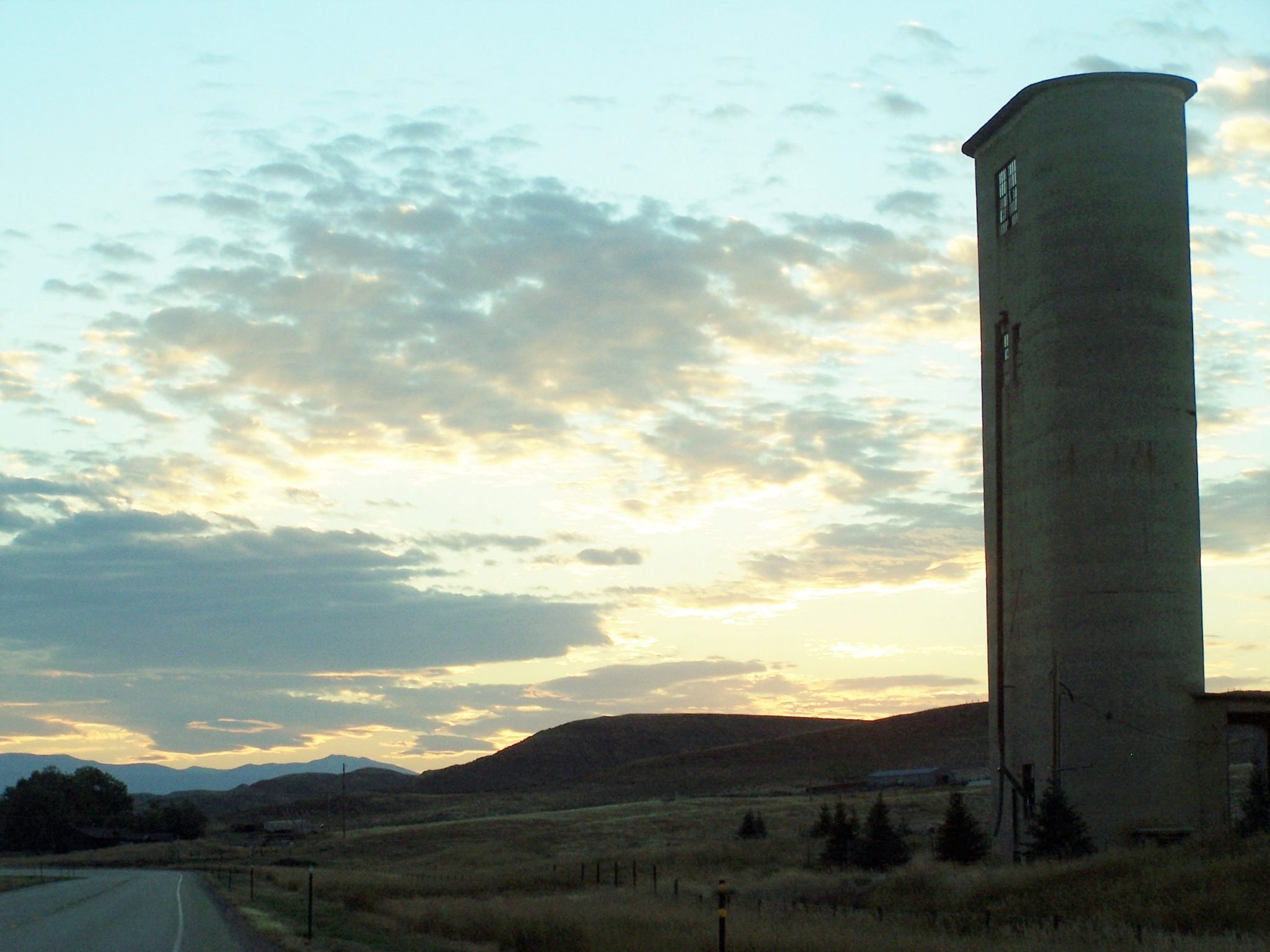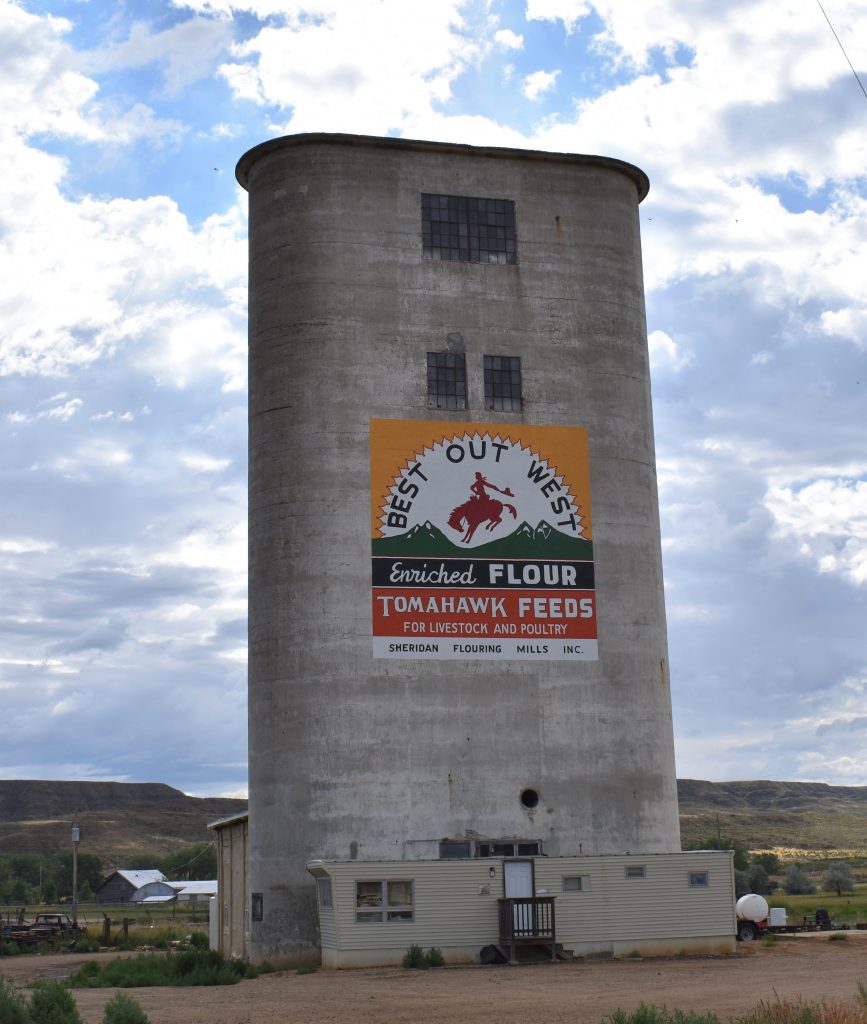News
History of the Towers Along Clear Creek

The grain elevator at the old Bebee Siding of the Wyoming Railroad near Ucross
Driving along highway 14/16 between Sheridan and Gillette, one sees three distinctive concrete ‘towers’ standing tall along the road. They are just like the one at The Mill Inn Motel, but why are they standing alone on the highway?
These concrete grain elevators were built between 1917 and 1920 by the LZ (Levi Ziegler) Leiter company, that owned many acres of prime farmland and down Clear Creek. The small town of Leiter bears his name, and there is a café, bar, and several motel cabins still in operation.
In 1897 and 1898, Leiter attempted to corner the wheat market and was briefly the largest individual holder of wheat in the history of the grain trade. Competitors kept this from happening, and Leiter lost a great deal of money on the deal. He came West, and found the Clear Creek Valley an ideal place to raise wheat and other grain. But he needed storage space, so he had the elevators built to store the harvested grain.
The elevators are identical in size and structure. There is one between Leiter and Clearmont, at the extinct town of Big Corrals. It is now privately owned by the Little Family. In an interview in 1996, Pat Little said this: “It holds 29,000 bushels of grain, two bins hold 12,000 bushels each; two hold 1,400 each, and the other six are smaller. The wheat was poured from trucks into a pit under the elevator, then carried to bins by means of a gas powered engine with a conveyor belt that carried scoops full of grain up into the bins. When the Little family purchased the elevator, they upgraded the engine from gas to electric.
Tom Weber, who owns the Clearmont elevator, said this, “…there were 16 chambers inside the elevator for grain storage, and a rope and pulley type elevator to raise the grain from the storage bid below the elevator to the chambers above.”
In 2020, Weber repainted the color sign on the elevator that advertised, “Best Out West Flour.” The Clearmont elevator and the one at The Mill Inn are the only two with color signs.

Little talked about the building of the Leiter elevator, forms were placed on the bottom, then jacked up, and cement was poured in to form the walls. One can see the lines in the side where the joints formed. The gravel for the concrete was hauled by wagon from Clear Creek, about a half-mile away. The crew put in the last layer of concrete on New Year’s Day, 1920. The workers had to keep a coal stove at the bottom of the silo going full blast to dry the concrete.
A September 1, 1916 article in the Sheridan Post mentions the wheat and flour grown and produced around Sheridan.
It was talking about a possible upcoming railroad strike. If the strike happened, the writer felt that Sheridan would be fine. “Whether the strike lasts three days or three months, Sheridan will have fuel, light, meat, flour, sugar milk and better. Sheridan Flour mills have large stocks of flour on hand, a new crop of wheat is practically ready to come in. Sheridan can revel in exceptional flour all winter long without a train from the outside.” At that time, most residents were pretty self-sufficient, needing little from the outside world.
The original Sheridan mill was established in the early 1890’s on Broadway by Captain Scott W. Snively. It was sold to J.W. Denio, in 1903 and operated under the name The J. W. Denio Milling Co., that milled the Pride of Sheridan Flour.
In 1919 a catastrophic fire destroyed the mill at the downtown location, and a new mill was built in 1920 and 1921 on Coffeen Avenue. It consisted of a mill building and a more compact six-story section, adjoined by a reinforced concrete grain elevator, like those built by Leiter farther east.

Later the company was re-named Sheridan Flouring Mills, and it shipped flour worldwide. During World War II the flour from Sheridan was shipped to all parts of the globe.
In an advertisement in The Enterprise February 16, 1906: Pride of Sheridan Flour it is made in Sheridan, from Sheridan county hard wheat and is the best flour on the market. Pride of Sheridan flour is cheaper in price but higher in quality than any of the flours which are shipped in. You get the best for the least money when you buy Pride of Sheridan flour. It pays to patronize a home industry. The J. W. Denio Milling Co. of PRIDE OF SHERIDAN Flour Phone 226 FOR SALE BY ALL GROCERS
Feb. 11, 1921, a short note in the Sheridan Post mentions the Big Corrals elevator; “Bert Smith, employed at the Leiter elevator, at the corrals, left Monday for his homestead.”
In 1927, Sheridan Flour Mills, Inc., purchased the elevators from the LZ Leiter estate. Later branded, Best Out West Flour and Tomahawk Feeds, it was well known throughout the US in its heyday in 1934
Clearmont Area ranchers planted and harvested winter wheat, and sold it to Sheridan Flouring Mills and later Best Out West Flours.
Wallace Vannoy, Clearmont rancher, wrote in his journals on Aug. 28, 1969, –“Finished combining. Now have 5825 bushels in Clearmont Elevator. 400 in seed wheat bin.” Sept 24, 1972 – “Combined 72 acres. (Elevator) is full of wheat and we can’t work tomorrow.”
In 1974, due to the changes in freight rates for grain and flour, the Sheridan mill could no longer compete. The operations were closed and the buildings and land were sold. Many ranchers switched their operations strictly to livestock, re-seeding the wheat fields in dry-land wheat grass for grazing.
The 1920 Sheridan Mill still stands, but is now The Mill Inn Motel and is listed on the National Register of Historic Places. The other three concrete towers still stand along Highway 14-16, a mute reminder of Sheridan’ County’s diverse past.


Mark Steingass
July 24, 2021 at 8:50 am
awesome job on the repaint Tom…well done
Cheryl K Reeves
July 24, 2021 at 10:28 am
I did not know this history. My grandfather managed the one at Clearmont and my Dad was a manager of the mill in Sheridan.
Mike Kuzara
July 25, 2021 at 9:40 am
Smaller auxiliary elevators constructed of timber and sheet metal were built, at Wyarno, Ranchester, and Wyola, and I believe I saw others further north. Whether they were owned by Leiter’s enterprise or by the Railroad, I do not know. Nice work on the report Cynthia!
Jim Nelson
July 25, 2021 at 1:59 pm
Enjoy this history as one who has driven US 14/16 from Ucross.